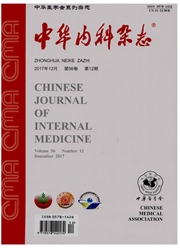

 中文摘要:
中文摘要:
目的探讨重组人粒细胞集落刺激因子(rhG—CSF)动员的供者外周血造血干细胞(PBSC)治疗异基因造血干细胞移植术后植入功能不良(PGF)的安全性及有效性。方法对2003年1月至2012年11月期间诊断PGF并接受PBSC治疗的患者进行回顾性分析,观察输注后30d血液学反应及回输后发生移植物抗宿主病(GVHD)的情况。结果28例PGF患者接受了PBSC治疗,其中男21例,女7例。中位年龄28(12~50)岁。16例为原发性PGF,12例为继发性PGF。回输的单个核细胞(MNC)中位数为2.0(1.0~5.8)×10/kg,随访至回输后6个月。28例患者中,12例(42.9%)在回输后30d获得血液学反应,总体有效率为53.6%(15/28)。回输后发生GVHD8例(28.6%)。最终存活16例(57.1%)。患者年龄(≤28岁/〉28岁)、性别、供者类型(同胞相合/亲缘不相合)、PBSC前是否接受预处理、初始中性粒细胞植活时间(≤18d/〉18d)、PBSC植活时间(≤100d/〉100d)及回输MNC数(≤2.0×108/kg/〉2.0×108/kg)对血细胞恢复没有影响。原发性PGF的30d有效率(4/16)明显低于继发性PGF(8/12)(P=0.022)。结论rhG-CSF动员的PBSC治疗可作为继发性PGF的一种治疗方案,但对于原发性PGF疗效欠佳。
 英文摘要:
英文摘要:
Objective To assess the efficacy and safety of recombinant human granulocyte colony stimulating factor (rhG-CSF) primed donor peripheral blood stem cell (PBSC) on the treatment of poor graft function (PGF) after allogeneic stem cell transplantation (allo-HSCT). Methods The patients diagnosed as PGF after allo-HSCT and transfused with rhG-CSF primed PBSC from January 2003 to November 2012 were retrospectively analyzed. Hematological response was assessed at day 30 after transfusion. Graft versus host disease (GVHD) was assessed until 6 months after transfusion. Results There were 28 patients including 21 men and 7 women with a median age of 28 ( 12-50 ) years old. Of these patients, 16 were diagnosed as primary PGF. The median number of transfused mononuelear cells was 2. 0 ( 1.0-5.8 ) x 108/kg. Totally 42. 9% ( 12/28 ) patients achieved good response. Eight patients ( 28.6% ) developed GVHD. Sixteen patients (57.1% ) survived. Age ( ~〈/〉 28 years) , gender, donor type ( matched sibling/ mismatched related ) , additional conditioning regimen prior to transfusion, time of neutrophil engraftment ( ~〈/〉 18 days) time of transfusion ( ~〈/〉 100 days after allo-HSCT) and number of mononuelear cells (~〈/〉 2. 0 x 10S/kg) did not impact hematological response. However, response rate of primary PGF (4/16) was significantly lower than that of secondary PGF (8/12) (P = 0. 022). Conclusion Transfusion of PBSC mobilized by rhG-CSF could be considered as an option to treat secondary PGF after allogeneic stem cell transplantation.
 同期刊论文项目
同期刊论文项目
 同项目期刊论文
同项目期刊论文
 期刊信息
期刊信息
